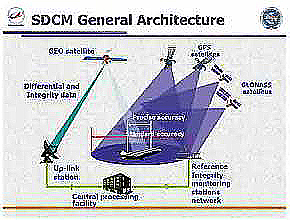 GLONASS-K spacecraft (artist’s illustration)
GLONASS-K spacecraft (artist’s illustration)With a nearly restored and modernizing GLONASS system beginning to make inroads into mass market products and services, Russia has revealed plans to build out a space-based augmentation system (SBAS) and establish its first ground monitoring stations outside the Russian territory.
In a July 30 presentation at an International Committee on GNSS (ICG) working group on interoperability, Dmitry Marareskul, head of the onboard satellite navigation sector of Information Satellite System Reshetnev Corporation in Zheleznogorsk, revealed Russia’s plans to expand its network of GLONASS monitoring and measuring stations to include sites in Australia, Cuba, and South America.
With a nearly restored and modernizing GLONASS system beginning to make inroads into mass market products and services, Russia has revealed plans to build out a space-based augmentation system (SBAS) and establish its first ground monitoring stations outside the Russian territory.
In a July 30 presentation at an International Committee on GNSS (ICG) working group on interoperability, Dmitry Marareskul, head of the onboard satellite navigation sector of Information Satellite System Reshetnev Corporation in Zheleznogorsk, revealed Russia’s plans to expand its network of GLONASS monitoring and measuring stations to include sites in Australia, Cuba, and South America.
Over the past year, Russia has signed a number of cooperation agreements to promote GLONASS, most recently with Brazil in July. Last September, Russian diplomats discussed the opportunities for cooperation on the joint use of GLONASS with Cuba and Venezuela, according to Anatoly Perminov, head of the Russian Federal Space Agency (Roscosmos).
The agency would like to establish ground monitoring stations outside the Russian territory in order to improve the integrity, accuracy, and reliability of GLONASS. Other reference stations in other countries will be needed to provide a robustness to the GLONASS operational control segment that is comparable to the network long-established by GPS.
An SBAS of Its Own
Meanwhile, Russia is advancing its plan to implement a GLONASS System of Differential Correction and Monitoring (SDCM) covering the Russian Federation. The system represents an SBAS counterpart to the GPS Wide Area Augmentation System (WAAS) and the European Geostationary Navigation Overlay Service (EGNOS).
The SDCM would perform integrity monitoring of both GPS and GLONASS satellites as well as provide differential corrections and a posteriori analyses of GLONASS system performance.
Using a network of ground reference stations and geostationary satellites, SDCM would provide real-time differential corrections with horizontal positioning accuracy of 1–1.5 meters and vertical accuracy of 2–3 meters. A centimeter-level real-time precise positioning service would be available within 200 kilometers around the base stations.
According to Nikolai Testoyedov, director general of the Reshetnev Research and Production Center in Krasnoyarsk that builds GLONASS and other Russian satellites, two geostationary satellites will be launched in 2010 and 2011 to support SDCM.
The satellites will carry payloads for providing GLONASS correction data. They apparently will be an extension of the Luch communications satellite design (also manufactured by Reshetnev) introduced in the 1980s as part of the Soviet Union’s satellite data relay network.
Luch-5A reportedly will be launched in December 2010 and Luch-5B in December 2011. According to a presentation by Sergey Revnivykh, deputy director general of the Central Research Institute for Machine Building, at the International Committee on GNSS (ICG) meeting last December, the spacecraft will be stationed at 16 degrees west longitude and 95 degrees east, respectively.
GLONASS-K, CDMA, and the Mass Market
According to Marareskul’s ICG presentation, the first GLONASS-K flight test model will be launched in December 2010 and will include broadcast of the new code division multiple access (CDMA) civil signal at the GLONASS L3 frequency centered at 1201.4 MHz.
Additional open CDMA signals at L1 and L5 will be added to the operational GLONASS-K spacecraft, he indicated. CDMA signals at L1 and L5 will make GLONASS more compatible and interoperable with other GNSS systems than the current frequency division multiple access (FDMA) signals at the upper L1 frequencies.
Industry sources have told Inside GNSS that a leading mobile telephone handset manufacturer will introduce units with GLONASS capabilities in the first or second quarter of next year, with other manufacturers following suit by the end of 2010. A number of GNSS chipset manufacturers are reportedly also working on adding GLONASS capabilities to high-volume OEM products.
Russian regulatory moves appear to be trying to expedite the process of building a mass market for the nation’s GNSS.
An Itar-Tass news agency report in July indicated that the Russian government is considering a proposal from the Industry and Trade Ministry and the Federal Tariff Service to eliminate import duties on GNSS components while raising those on finished GPS products by 25 percent. The objective is to stimulate domestic manufacturing of high-volume GLONASS and GLONASS-GPS user equipment.
Moreover, according to Deputy Premier Sergei Ivanov, Russia’s transport ministry is devising a technical regulation that would require all federal agencies to use only vehicles, vessels, and aircraft manufactured in Russia to be equipped with a GLONASS receivers.
Two launches of GLONASS-M satellites in September (three) and December (two Ms, one K satellite) 2010 are expected to bring the system to its full operational capability (FOC) of 24 spacecraft.
Although the GLONASS almanac continues to report 20 operational satellites in the current constellation, two spacecraft were off-line for maintenance as of August 19. Triple GLONASS-M launches are also scheduled for September and December this year, which could actually result in an effective FOC status (99.97 percent global availability of three-dimensional positioning) much earlier than the end of 2010.
With continuing modernization of the system, Russia expects that by 2012 GLONASS will have a 0.7-meter pseudorange error (compared to 1.8 meters at the end of 2008), a system time steered within 6 nanoseconds of coordinated universal time (UTC), and 1.4-meter stand-alone horizontal positioning accuracy (currently 5 meters).






